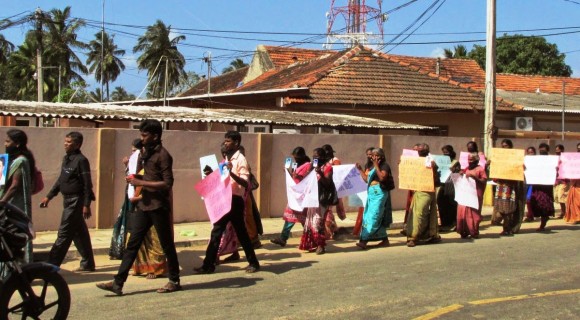Written by: Jessica Chandrashekar

One of several protests that has been recently held in the NorthEast. The protests have been organized by Tamil families of those who have been disappeared throughout the genocidei.
 This Mexican proverb was widely circulated after the enforced disappearances of 43 Mexican student activistsii. The proverb also aptly describes the families of the disappeared in post-2009 occupied Eelam. Recently, there has been a wave of protests throughout the North East against State sanctioned disappearances of Eelam Tamils; and the families of the disappeared have been at the frontlines of this struggle.
This Mexican proverb was widely circulated after the enforced disappearances of 43 Mexican student activistsii. The proverb also aptly describes the families of the disappeared in post-2009 occupied Eelam. Recently, there has been a wave of protests throughout the North East against State sanctioned disappearances of Eelam Tamils; and the families of the disappeared have been at the frontlines of this struggle.
An enforced disappearance is defined as: “the arrest, detention, abduction or any other form of deprivation of liberty by agents of the State”iii. Sri Lanka has the second highest number of enforced disappearances in the world – the first being Iraq.
The Sri Lankan state uses a policy of enforced disappearances against those who are critical of its genocide on the Eelam Tamil population. Sri Lankan state agents, such as the police and army, use a broad network of white vans and secret detention centres to abduct Tamils from their homes, on the street, in hospitals or checkpoints. Tamil journalists, activists and students are often targeted. Enforced disappearances are used as a way to send a message to the wider Tamil community, a warning to anyone who may have been considering speaking out against the state’s oppression.
This is what makes enforced disappearances a form of structural violence, because they are organized, supported and carried out by the Sri Lankan state. The effect of these enforced disappearances is the destruction of the broader social fabric of Tamil society because it is the entire family, community and Tamil nation who suffer.
 From the 2009 phase of the genocide alone there are 146, 679 unaccounted Tamilsiv. This number does not include those who went missing before. These are mothers, fathers, siblings and children whose fate and whereabouts remain unknown.
From the 2009 phase of the genocide alone there are 146, 679 unaccounted Tamilsiv. This number does not include those who went missing before. These are mothers, fathers, siblings and children whose fate and whereabouts remain unknown.
One such person is Mahindan Balendran. Mahindan, his mother and sister survived Mullivaikaal. In May 2009 Mahindan’s mother Jeyakumari Balendran took her son, an LTTE member, to surrender, due to the instructions provided by the Sri Lankan Army.
During this time, many mothers, fathers, husbands and wives, handed over their loved ones to the Sri Lankan army. Thousands of Tamils surrendered, expecting that they would be reunited with their families. Most were not.
After 2009, the Sri Lankan government officials have begun coercing the families of the disappeared to stop searching for their loved ones and to apply for death certificates. This is a way of trying to ‘bury’ the horrors of 2009. There are two major reasons why the Sri Lankan state encourages Tamil families to apply for death certificates. One reason is that the government can then fabricate a cause and date of death, making this a matter of official record – even if it is untrue or not proven. For example, consider the people who went missing while seeking safety in the ‘no fire zone’ in 2009. If they are indeed deceased, they were most probably killed as they were targeted by Sri Lankan government shelling. However, the government can issue a death certificate for a date of death as of 2010 and can list the cause of death as ‘unknown’. The number of Tamils unaccounted for after the 2009 massacre is astounding- issuing death certificates is a way covering up genocide.
Another reason the government encourages death certificates is so that the family is no longer allowed to formally inquire with the courts, police stations or other state officials on the whereabouts of the disappeared. Even if the family comes to know of new information that their loved one may still be alive, they have no official way of searching or confirming. If the disappeared person is actually alive, the state can then imprison, torture and execute that person at will and with impunity, because officially that person is already dead.

Jeyakumari Balendran and her 13-year old daughter Vipooshika, prominent human rights campaigners who have been imprisoned- arrested under Sri Lanka’s Prevention of Terrorism Act v.
What if Jeyakumari Balendran applied for a death certificate for Mahindan? May 2009 was the last time Jeyakumari Balendran saw her son and the last time her daughter, Vipooshika saw her anna- until Mahindan’s photo was printed in a Sri Lankan government publication promoting its supposed ‘rehabilitation’ of LTTE cadres.
Seeing Mahindan’s photo was proof that their relentless search was not in vain. However, not giving up on Mahindan, and speaking out against the Sri Lankan state’s treatment of Tamils has come at a cost.
Since 2009, Jeyakumari Balendran and 13-year old Vipooshika have been at the frontlines of the fight to find the disappeared. On March 13, 2014 mother and daughter were arrested under the Prevention of Terrorism Act. Their home was surrounded by hundreds of police and armyvi. It has now been almost one year since Jeyakumari Balendran has been imprisoned and Vipooshika taken into state custody.
“They tried to bury us. They didn’t know we were seeds”. The families of the disappeared, including Jeyakumari and Vipooshika, are seeds. The Sri Lankan state has tried to bury them in prisons, threaten them with violence and intimidate them into silence. Yet they are seeds, their resilience takes root and their strength grows; and their strength calls on us to struggle – in solidarity – for truth and justice.
Disclaimer: All views and opinions expressed in this article are those of the author and do not necessarily reflect www.tamilyouth.ca’s views and opinions.
Sources:
ihttp://tamilnet.com/art.html?catid=13&artid=37614
iihttp://america.aljazeera.com/articles/2014/10/29/mexico-students-missing.html
iiihttp://www.ohchr.org/EN/HRBodies/CED/Pages/ConventionCED.aspx
ivOf these people, many were killed by the Sri Lankan army, buried in mass graves, many others put into internment camps, some later executed. Thousands are still alive, kept in secret internment camps and prisons. See http://www.pptsrilanka.org/
vhttp://www.jdslanka.org/index.php/analysis-reviews/human-rights/481-detention-of-balenderan-jeyakumari-why-it-is-so-sinister
Tags: army, disappearance, eelam, Genocide, occupation, Sri Lanka, state


